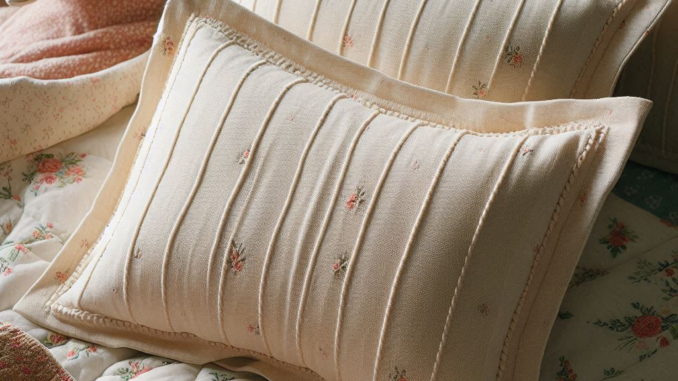
How to Make Pillow Cases with French Seams?
Are you looking to add a touch of elegance to your bedroom while honing your sewing skills? Making pillow cases with French seams is the perfect project for you! This technique not only gives your bedding a professional finish but also increases its durability. In this guide, we’ll walk you through the process step-by-step, whether you’re a beginner or an experienced sewer.
Quick Answer
To make pillow cases with French seams, cut your fabric, sew the wrong sides together with a 1/4″ seam, trim, turn inside out, then sew a 3/8″ seam to encase the raw edges. Finish by hemming the open end.
My French Seam Journey
I remember the first time I attempted French seams. It was a chilly autumn evening, and I was determined to upgrade my bedding game. As I sat at my grandmother’s old Singer sewing machine, fabric in hand, I felt a mix of excitement and nervousness. The concept seemed tricky, but as I started working, each step clicked into place. When I finally slipped my pillow into that first case, the clean lines and hidden seams filled me with pride. That moment sparked my love for this technique, and I’ve been using it ever since!
What You’ll Need
- Fabric of your choice (cotton works great)
- Thread that matches your fabric
- A sewing machine
- Sharp scissors or a rotary cutter
- Measuring tape or ruler
- Pins or fabric clips
- Iron and ironing board
Step-by-Step Guide

1. Prep Your Fabric
First things first, let’s get that fabric ready! Wash and iron it to avoid any surprises after you’ve done all the hard work. This step is super important because it pre-shrinks your fabric and gets rid of wrinkles. Trust me, you don’t want to spend hours sewing only to have your pillow case shrink in the wash later!
2. Measure and Cut
Now, let’s size things up. For a standard pillow (20″ x 26″), you’ll need to cut two pieces of fabric:
- Front piece: 21″ x 27″
- Back piece: 21″ x 27″
We’re adding an extra inch all around for our seam allowance. Accuracy is key here, so take your time with the measuring and cutting. A rotary cutter can be your best friend for getting those edges nice and straight!
3. The First Seam
Here’s where the magic begins! Place your fabric pieces wrong sides together. Yes, you read that right – we’re starting with the wrong sides facing each other. This is the secret to French seams. Pin or clip the edges together, then sew a 1/4″ seam around three sides, leaving one short end open. Use a straight stitch and don’t forget to backstitch at the start and end!
4. Trim and Press
Time for a little trim! Cut the seam allowance down to about 1/8″. Be careful not to snip your stitches. Then, break out that iron and press those seams flat. This might seem like a small step, but it makes a big difference in the final look.
5. The Big Flip
Now for the fun part – turn that pillow case inside out! The right sides should now be facing each other. Use your fingers or a pointy tool (like a chopstick) to push out those corners. You want them nice and sharp. Once you’re happy with the shape, press those seams again. Can you see your pillow case starting to take shape?
6. The French Seam Magic
Here’s where we create the actual French seam. Sew another seam, this time 3/8″ from the edge. This seam will encase the raw edges from your first seam, giving you that clean, professional finish. Take your time with this step – it’s the star of the show!
7. Hemming the Opening
We’re in the home stretch now! For the open end of your pillow case, fold the edge over 1/4″ and press. Then fold it over another 1/4″ and press again. This double fold hides the raw edge inside. Sew along the folded edge to secure your hem. Voila! Your pillow case is almost complete.
8. Final Touches
Give your pillow case one last press to smooth out any wrinkles. Take a moment to admire your handiwork – those French seams look pretty great, don’t they?
Pro Tips for Perfect Pillow Cases
- Thread tension matters: Make sure your machine’s tension is balanced for even stitches.
- Press, don’t iron: Use an up-and-down motion with your iron instead of sliding it to avoid stretching your fabric.
- Test first: If you’re new to French seams, practice on some scrap fabric before tackling your pillow case.
- Fabric choice is key: Light to medium-weight fabrics work best for French seams. Heavy fabrics can get bulky.
Frequently Asked Questions
Can I use French seams on other projects?
Absolutely! Once you master French seams, you’ll want to use them everywhere. They’re great for garments, especially those made with light fabrics. I’ve used them on blouses, skirts, and even lightweight curtains. They give everything a high-end, tailored look.
How do I care for my French-seamed pillow cases?
Good news – French seams are tough! Wash your pillow cases according to the fabric care instructions. Generally, a gentle machine wash and low-heat tumble dry will keep them looking great. The enclosed seams mean less fraying, so your pillow cases should last longer than those with standard seams.
Can I make French seams by hand?
While it’s easier with a machine, you can definitely create French seams by hand. It’ll take longer, but the result can be just as beautiful. Use a backstitch for strength and keep your stitches small and even. It’s a great option if you’re looking for a quiet, relaxing sewing project.
Why French Seams are Worth the Extra Effort
You might be wondering, “Why go through all this trouble for a pillow case?” Well, let me tell you, the benefits are worth it:
- Durability: French seams are stronger than standard seams, meaning your pillow cases will last longer.
- Professional finish: The enclosed seams give your work a high-end, tailored look.
- No raw edges: Say goodbye to fraying! All raw edges are neatly tucked away.
- Comfort: Without exposed seams, your pillow cases will feel smoother against your skin.
Wrapping Up
Congratulations! You’ve just learned how to make pillow cases with French seams. This skill will not only upgrade your bedding but can also be applied to many other sewing projects. Remember, practice makes perfect, so don’t get discouraged if your first attempt isn’t flawless. Each pillow case you make will be better than the last.
Why not challenge yourself to make a set of matching pillow cases? Or experiment with different fabrics and patterns? The possibilities are endless, and your bedroom (or a lucky gift recipient) will thank you for the effort.
Happy sewing, and sweet dreams on your beautiful new pillow cases!


Leave a Reply